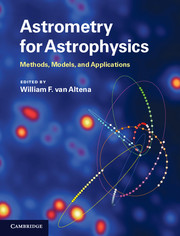Book contents
- Frontmatter
- Contents
- List of contributors
- List of acronyms
- Preface
- Part I Astrometry in the twenty-first century
- 1 Opportunities and challenges for astrometry in the twenty-first century
- 2 Astrometric satellites
- 3 Ground-based opportunities for astrometry
- Part II Foundations of astrometry and celestial mechanics
- Part III Observing through the atmosphere
- Part IV From detected photons to the celestial sphere
- Part V Applications of astrometry to topics in astrophysics
- Index
- References
3 - Ground-based opportunities for astrometry
from Part I - Astrometry in the twenty-first century
Published online by Cambridge University Press: 05 December 2012
- Frontmatter
- Contents
- List of contributors
- List of acronyms
- Preface
- Part I Astrometry in the twenty-first century
- 1 Opportunities and challenges for astrometry in the twenty-first century
- 2 Astrometric satellites
- 3 Ground-based opportunities for astrometry
- Part II Foundations of astrometry and celestial mechanics
- Part III Observing through the atmosphere
- Part IV From detected photons to the celestial sphere
- Part V Applications of astrometry to topics in astrophysics
- Index
- References
Summary
Introduction
Chapter 1 surveys the opportunities and challenges for astrometry in the twenty-first century (van Altena 2008) while Chapter 2 discusses space satellites primarily designed for astrometry. We now review the situation for ground-based astrometry, since it is often mistakenly stated that there is no longer any need to pursue ground-based research once satellites are operating. It is certainly true that the levels of precision and accuracy projected for Gaia and others are far beyond what can be achieved from the ground. However, there are also consequences of the fairly small aperture size and short flight durations that impose constraints on the limiting magnitudes and our ability to study long-term perturbations. In this chapter we will explore those areas of research using astrometric techniques that will be able to make important contributions to our understanding of the Universe in the coming years, even with high-accuracy satellites such as Gaia operating.
Radio astrometry
It is likely that radio astrometry observations (see Chapter 12 for a detailed discussion of radio astrometry and interferometry) will continue to be made primarily from the ground due to the difficulty and cost of launching large objects into space. Since the diffraction limit of a telescope is inversely proportional to the wavelength and radio wavelengths are about 103 to 105 times longer than those of visible light, no high-resolution imaging or high-precision angular measures can be performed with a single radio telescope.
- Type
- Chapter
- Information
- Astrometry for AstrophysicsMethods, Models, and Applications, pp. 29 - 36Publisher: Cambridge University PressPrint publication year: 2012

